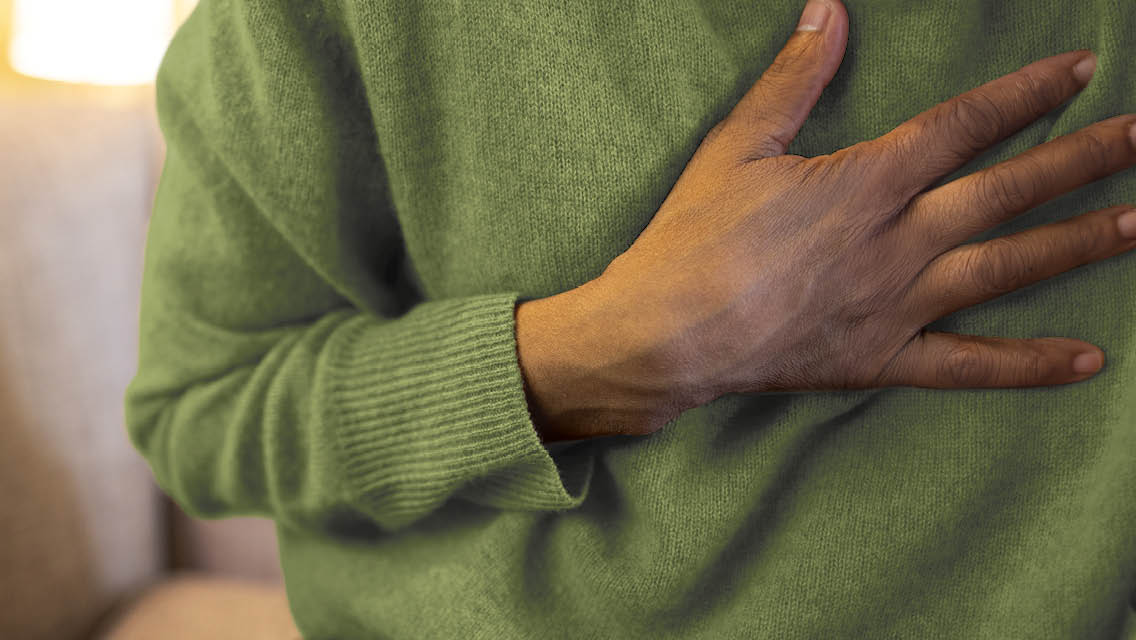What’s the difference between stumbling on a grizzly bear den and speaking in front of a group of people?
It may sound like a trick question, but your brain can’t necessarily distinguish between these situations: The same physiological processes that fire up if you encounter the bear may kick in at the podium (or in an airplane, crowded elevator, or whatever other not-actually-dangerous situation sends your anxiety soaring).
And sometimes these processes can escalate to a full-blown panic attack, an abrupt, intense surge of fear and physical discomfort. Though they are usually short lived — symptoms typically peak within a few minutes — panic attacks can be downright terrifying. Common symptoms include heart palpitations, sweating, shaking, shortness of breath, chest pain, nausea, dizziness, chills, heat, numbness, a feeling of disconnection from your surroundings (known as derealization), a feeling of disconnection from your own body (known as depersonalization), a fear that you are “going crazy,” or a fear that you’re going to die.
The attacks themselves are generally harmless, but long-term consequences abound. Panic attacks may lead to missed school or work, unnecessary medical bills (it’s not uncommon for people to misinterpret a panic attack as a heart attack and check themselves into the ER), and suicidal ideation. Fortunately, understanding why panic attacks occur and what to do if you’re having one reduces much of their power.
Who Gets Panic Attacks — and Why?
Roughly one in three people will experience a panic attack at some point in their lives. Those who have suffered from trauma or abuse are more likely to experience one, as are individuals experiencing recent stressors such as job loss or the death of a loved one. Women are more than twice as likely as men to be diagnosed with a panic disorder, and individuals prone to negative emotional states like anxiety and depression, are also more likely to experience an attack.
Ironically, having a panic attack can be a risk factor as well. Because they are so terrifying, fear of experiencing another one can cause people to remain on high alert for warning signs. And this kind of hypervigilance only primes the panic pump.
Panic attacks can be triggered by a known phobia or trauma-related cue but may also come out of the blue. Some people experience nocturnal panic attacks — awakening in a state of panic.
Though it’s not always clear what triggers them, the physiological mechanisms that kick panic attacks into gear are well understood.
The human brain is wired to respond immediately to danger thanks largely to the amygdala, a neurological structure we share with our animal counterparts. When activated, the amygdala initiates what’s known as the stress response, a range of physiological changes such as increased heart rate, rapid breathing, and increased blood flow to the major muscles of the arms and legs.
By design, the amygdala can react to situations it perceives as dangerous far more quickly than the logical prefrontal cortex. After all, if we had to stop and analyze every situation before our bodies kicked into gear, our ancestors may never have survived.
While most of us rarely encounter actual life-and-death threats, our brains have not evolved accordingly. As a result, our bodies react in essentially the same way to a real threat — say, a charging grizzly — as they do to a perceived threat, like public speaking. And once the amygdala has been activated, it overrides the calm, rational part of our brain that can make those differentiations. It takes time — usually at least a few minutes — for the stress response to pass and the cortical “thinking brain” to take over.
Although the amygdala is responsible for the physiological experience of a panic attack, our cortical brain sometimes ignites the reaction. That’s because the amygdala responds similarly to what we imagine might happen as it responds to what is actually happening.
Say you receive a vague email from your boss requesting a meeting to discuss “internal changes.” What does that mean? you think. Am I getting fired? You begin replaying recent conversations with your boss and colleagues, scanning for signs that you’re on the chopping block. You imagine telling your partner you won’t be able to contribute to rent this month. Before long, your heart is racing and your muscles are clenching. Your old friend the amygdala interprets these physiological changes as proof of danger and pulls the fire alarm: panic attack!
This bi-directional process helps explain why past panic attacks can make us more vulnerable to future panic attacks. A situation, memory, or physical sensation which reminds us of the experience may trigger worry that it will occur again — which, in turn, may trigger the exact mechanisms that lead to panic attacks.
What to Do for a Panic Attack
A panic attack will eventually end on its own, but you can ease the process by sending the message to your amygdala that it’s safe to stand down. Here are several ways to do so.
- Breathe deep to counter hyperventilation with its opposite: slow breaths originating from your diaphragm rather than your chest (place one hand on your abdomen and one on your chest to ensure you’re breathing from your belly). (Try this mindful breathing practice that may help you to turn a stressful situation into a learning opportunity.)
- Place an ice pack on your face or the back of your neck. Cold exposure can help bring your heart rate back to baseline.
- Scan your body to notice which areas are tight, then try flexing and releasing the muscles until they soften on their own. Tight muscles increase amygdala activation; relaxed muscles signify safety.
- Move your body to reduce adrenaline and burn off excess glucose that was released into the bloodstream as part of the stress response. Stick with mildly aerobic physical activity, such as a brisk walk, to avoid re-accelerating your heart rate.
- Reorient yourself to the present moment. Especially during panic attacks triggered by trauma reminders, it’s crucial to engage your senses to help redirect your mind to the here and now. Consider sniffing a calming scent such as lavender or sucking on a mint.
- Use the 5-4-3-2-1 technique: Scan your surroundings and identify five things you can see, four things you can touch, three things you can hear, two things you can smell, and one thing you can taste. This will help reorient yourself to your surroundings.
- Remind yourself that panic attacks can’t kill you. This will help break the cycle of worrying about future attacks.
What Not to Do for a Panic Attack
Some of our most reflexive behaviors actually exacerbate symptoms of panic and make us susceptible to future attacks. Here’s what not to do if you experience a panic attack.
- Don’t try to engage the rational brain when you’re in a state of panic. Telling yourself to “calm down” or “stop overreacting” goes nowhere when the cortex is offline, plus scolding yourself in the heat of stress may only make you feel worse.
- Don’t remain immobilized. Freezing is a form of avoidance, which teaches your brain that whatever is happening isn’t safe. Call a friend, play sudoku, watch a YouTube video — do something to thaw the freeze.
- Avoid the flee response. Trying to escape the situation inadvertently teaches your brain that panic attacks are a true sign of danger rather than a misinterpretation of cues.





This Post Has 0 Comments